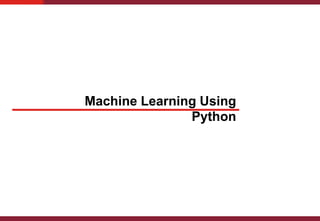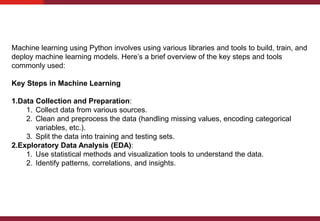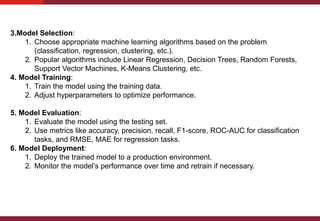Machine Learning Using Python.pptx Machine Learning Using PythonMachine Learning Using Python
- 3. Machine learning using Python involves using various libraries and tools to build, train, and deploy machine learning models. Here’s a brief overview of the key steps and tools commonly used: Key Steps in Machine Learning 1.Data Collection and Preparation: 1. Collect data from various sources. 2. Clean and preprocess the data (handling missing values, encoding categorical variables, etc.). 3. Split the data into training and testing sets. 2.Exploratory Data Analysis (EDA): 1. Use statistical methods and visualization tools to understand the data. 2. Identify patterns, correlations, and insights.
- 4. 3.Model Selection: 1. Choose appropriate machine learning algorithms based on the problem (classification, regression, clustering, etc.). 2. Popular algorithms include Linear Regression, Decision Trees, Random Forests, Support Vector Machines, K-Means Clustering, etc. 4. Model Training: 1. Train the model using the training data. 2. Adjust hyperparameters to optimize performance. 5. Model Evaluation: 1. Evaluate the model using the testing set. 2. Use metrics like accuracy, precision, recall, F1-score, ROC-AUC for classification tasks, and RMSE, MAE for regression tasks. 6. Model Deployment: 1. Deploy the trained model to a production environment. 2. Monitor the model’s performance over time and retrain if necessary.
- 5. Key Python Libraries 1.NumPy: 1. Fundamental package for scientific computing with Python. 2. Provides support for arrays, matrices, and many mathematical functions. 2.Pandas: 1. Data manipulation and analysis library. 2. Provides data structures like DataFrame for handling tabular data. 3.Matplotlib and Seaborn: 1. Libraries for data visualization. 2. Matplotlib is the core plotting library, while Seaborn is built on top of it and provides a high-level interface for drawing attractive statistical graphics.
- 6. 4. Scikit-learn: 1. A comprehensive library for machine learning. 2. Provides simple and efficient tools for data mining and data analysis. 5. TensorFlow and Keras: 1. Libraries for deep learning. 2. TensorFlow is an open-source platform for machine learning, and Keras is an API designed for human beings, not machines, which makes it easy to build and train neural networks. 6. PyTorch: 1. An open-source machine learning library based on the Torch library. 2. Used for applications such as computer vision and natural language processing.





